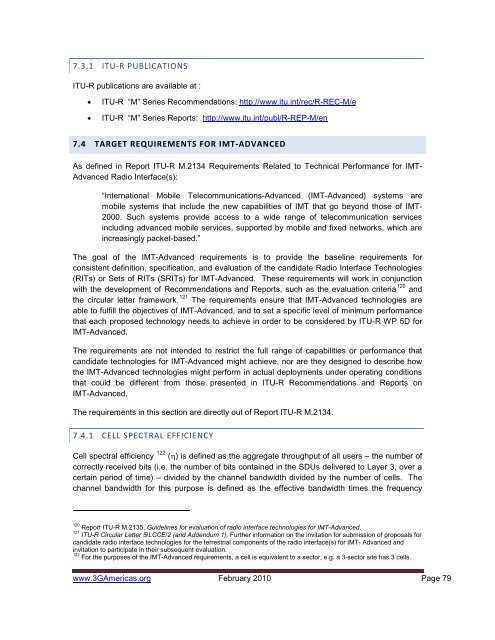UMTS: Alive and Well - 4G Americas
UMTS: Alive and Well - 4G Americas
UMTS: Alive and Well - 4G Americas
You also want an ePaper? Increase the reach of your titles
YUMPU automatically turns print PDFs into web optimized ePapers that Google loves.
7.3.1 ITU-R PUBLICATIONSITU-R publications are available at :• ITU-R “M” Series Recommendations: http://www.itu.int/rec/R-REC-M/e• ITU-R “M” Series Reports: http://www.itu.int/publ/R-REP-M/en7.4 TARGET REQUIREMENTS FOR IMT-ADVANCEDAs defined in Report ITU-R M.2134 Requirements Related to Technical Performance for IMT-Advanced Radio Interface(s):“International Mobile Telecommunications-Advanced (IMT-Advanced) systems aremobile systems that include the new capabilities of IMT that go beyond those of IMT-2000. Such systems provide access to a wide range of telecommunication servicesincluding advanced mobile services, supported by mobile <strong>and</strong> fixed networks, which areincreasingly packet-based.”The goal of the IMT-Advanced requirements is to provide the baseline requirements forconsistent definition, specification, <strong>and</strong> evaluation of the c<strong>and</strong>idate Radio Interface Technologies(RITs) or Sets of RITs (SRITs) for IMT-Advanced. These requirements will work in conjunctionwith the development of Recommendations <strong>and</strong> Reports, such as the evaluation criteria 120 <strong>and</strong>the circular letter framework. 121 The requirements ensure that IMT-Advanced technologies areable to fulfill the objectives of IMT-Advanced, <strong>and</strong> to set a specific level of minimum performancethat each proposed technology needs to achieve in order to be considered by ITU-R WP 5D forIMT-Advanced.The requirements are not intended to restrict the full range of capabilities or performance thatc<strong>and</strong>idate technologies for IMT-Advanced might achieve, nor are they designed to describe howthe IMT-Advanced technologies might perform in actual deployments under operating conditionsthat could be different from those presented in ITU-R Recommendations <strong>and</strong> Reports onIMT-Advanced.The requirements in this section are directly out of Report ITU-R M.2134.7.4.1 CELL SPECTRAL EFFICIENCYCell spectral efficiency 122 (η) is defined as the aggregate throughput of all users – the number ofcorrectly received bits (i.e. the number of bits contained in the SDUs delivered to Layer 3, over acertain period of time) – divided by the channel b<strong>and</strong>width divided by the number of cells. Thechannel b<strong>and</strong>width for this purpose is defined as the effective b<strong>and</strong>width times the frequency120 Report ITU-R M.2135, Guidelines for evaluation of radio interface technologies for IMT-Advanced.121 ITU-R Circular Letter 5/LCCE/2 (<strong>and</strong> Addendum 1), Further information on the invitation for submission of proposals forc<strong>and</strong>idate radio interface technologies for the terrestrial components of the radio interface(s) for IMT- Advanced <strong>and</strong>invitation to participate in their subsequent evaluation.122 For the purposes of the IMT-Advanced requirements, a cell is equivalent to a sector, e.g. a 3-sector site has 3 cells.www.3G<strong>Americas</strong>.org February 2010 Page 79
















